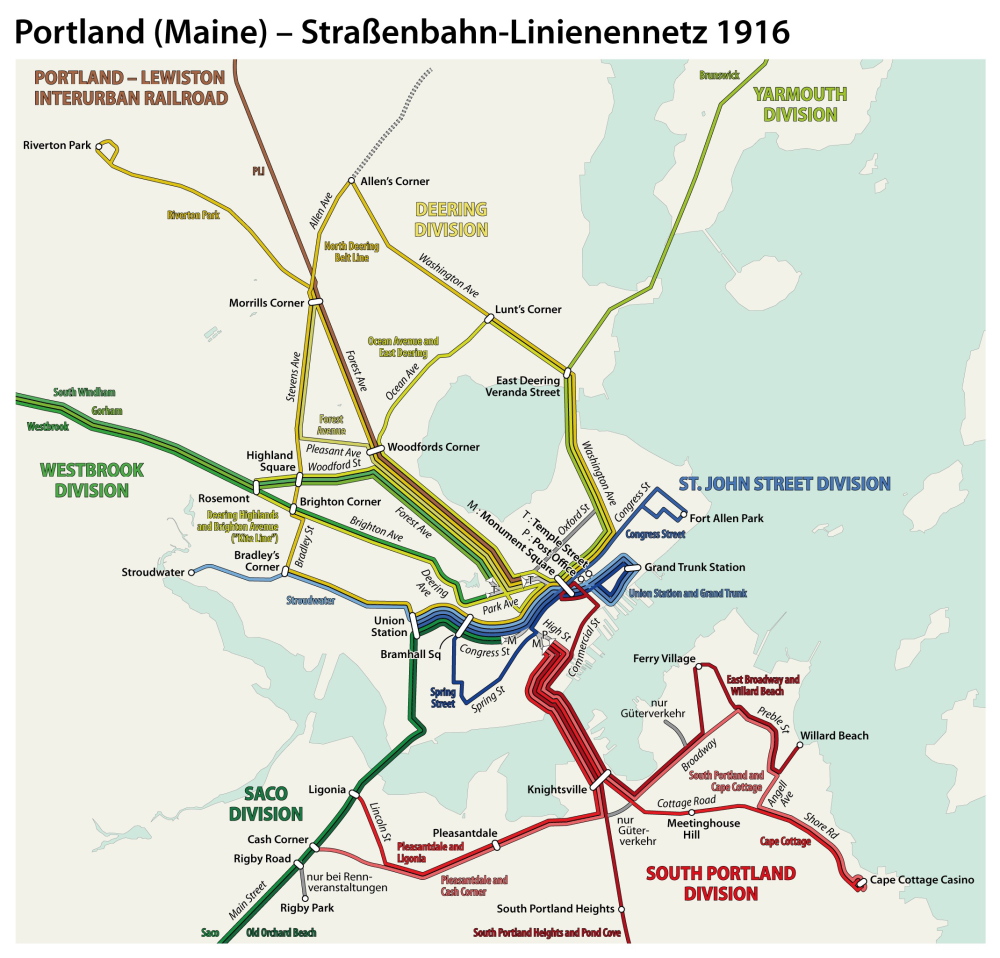DAMARISCOTTA — Your Sept. 20 editorial, “Our View: Bus service is good, but train would be better,” could as well have mentioned that, per passenger mile, a transit bus uses 42 percent more energy (1.08 kilowatt-hours) than a passenger train (0.63 kwh) and 69 percent more than electric light rail (0.34 kwh) and that vehicles running along a fixed route are more easily electrified – important if we are serious about getting off fossil fuels.
“Trains are hard to introduce because of the high cost of laying track and building facilities for passengers to get on and off,” the editorial observes. But resistance to light rail is more likely to be political than logistical, since laying track is generally less expensive than building a multi-lane road, and tracks are way less expensive to maintain.
Tracks already exist for a regional light rail system around Portland. These tracks are either publicly owned or a strong claim can be made for their public use.
When U.S. railroads were built, they were heavily subsidized by the federal government (taxpayers) providing free or very-low-cost land for rights of way, for example. Lightly used or unused tracks exist between Portland and towns along the Western Division of the old Maine Central Railroad, south toward Kittery and north to Brunswick, Rockland, Augusta, Lewiston and intermediate towns.
As for getting on and off, low-floor light rail cars don’t require any facility more complex than does a bus. A curb will do and, even without a curb, people can easily get on and off. Unlike buses, light rail can also handle freight – including forwarding freight rail cars – solving the problems of businesses stranded without rail transport when private freight railways abandon service.
Portland used to have a state-of-the-art network of light rail. In addition to streetcar lines, interurban service was provided by the likes of the Portland-Lewiston Interurban and the Atlantic Shore Line railways.
Such successful metropolitan rail nets still abound. The network around Karlsruhe, Germany (on which the street layout of Washington, D.C., was modeled), may be especially relevant. The Karlsruhe model of public transit integrates urban light rail with high-speed long-distance trains.
Vehicles share the same tracks, including those of the German Federal Railways. Safety and timely operations are ensured by a sophisticated computerized traffic control system. This integrated system provides local and commuter service, as well as long-distance and freight service, using the same facilities.
Around the world, cities use light rail networks for economic development in imaginative ways. Stops along the lines anchor not only local businesses but also walkable neighborhoods. These reduce sprawl and attract both young families and an aging population.
Cities often invest in still-inexpensive land along future light rail lines and benefit from the rise in land prices as the rail lines are developed. These investments can go a long way to finance the development of light rail.
As already mentioned, beyond the need to lay tracks along Portland’s streets where streetcars once were common, there are tracks ready to be put to use as light rail lines as early as tomorrow. Light rail could be a boon to the economy of a wide area around Portland.
Not to belabor that every dollar not spent on fossil fuels stays in the Maine economy, ready to pay for much-needed jobs, secondary benefits of a light rail system would include reduced traffic and wear and tear on our overloaded, expensive and ill-maintained road system. For starters, we may run diesel electric rail cars whose use has been discontinued elsewhere. But longer-term, any rail line is easily electrified and adapted to renewable energy use.
As for buses, they are ideal for delivering passengers to the nearest rail stop. In an ideal world, I could walk or take an electric bus to the nearest light rail stop, board a light rail train and read or get some work done on my way to the city – instead of fighting road traffic and wasting energy by driving alone in a car.
This is no dream. It is taken for granted from Zurich to St. Petersburg, Russia.
— Special to the Press Herald
Send questions/comments to the editors.



Success. Please wait for the page to reload. If the page does not reload within 5 seconds, please refresh the page.
Enter your email and password to access comments.
Hi, to comment on stories you must . This profile is in addition to your subscription and website login.
Already have a commenting profile? .
Invalid username/password.
Please check your email to confirm and complete your registration.
Only subscribers are eligible to post comments. Please subscribe or login first for digital access. Here’s why.
Use the form below to reset your password. When you've submitted your account email, we will send an email with a reset code.